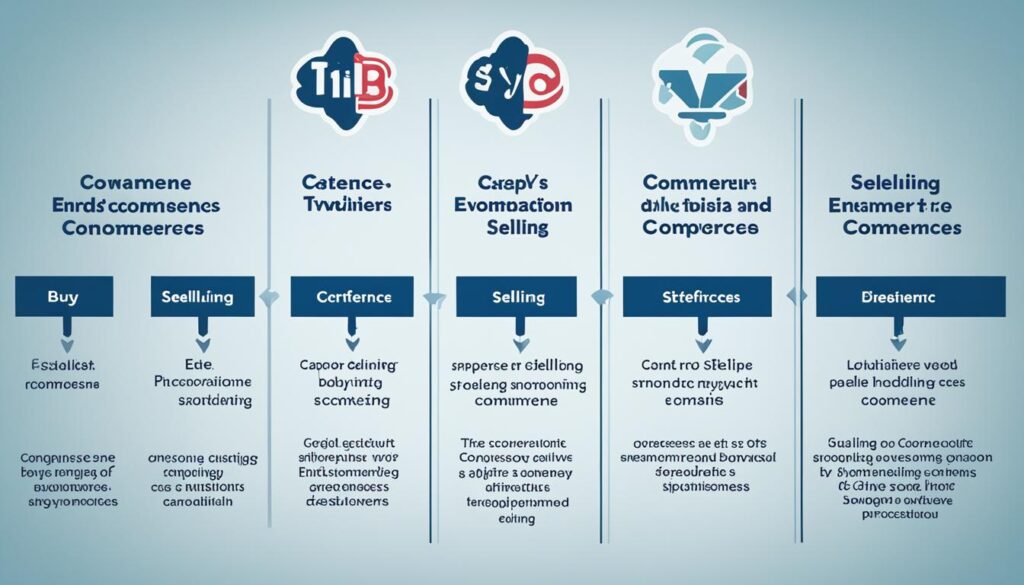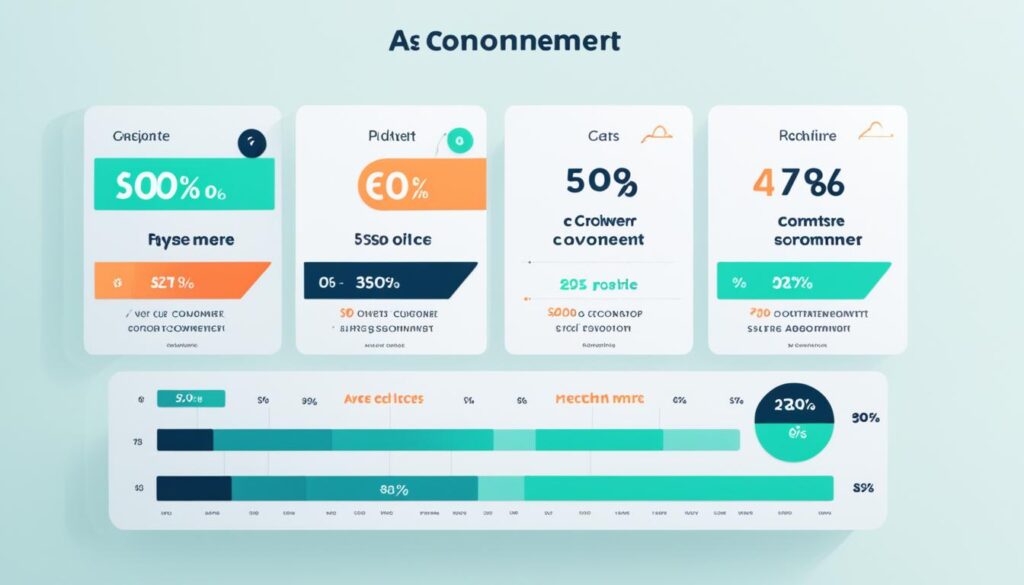The world of ecommerce is booming, and with that comes a slew of employment opportunities in the ecommerce space. Whether you’re interviewing for a job in ecommerce or conducting interviews for your next hire, it’s important to have a list of interview questions ready. In this article, we will provide the top ecommerce interview questions and answers to help you ace your next job interview in the ecommerce industry.
Are you ready to take your ecommerce career to the next level? Let’s dive into the most common ecommerce interview questions and equip you with the knowledge to succeed.
Core Features of Ecommerce
Ecommerce is a dynamic and multifaceted field that encompasses various features and components. To showcase your understanding of ecommerce, it’s essential to familiarize yourself with its core features. These features enable businesses to thrive in the online marketplace and provide customers with a seamless shopping experience.
1. Top-of-Funnel Marketing
Attracting potential customers is a crucial aspect of ecommerce. Implementing effective top-of-funnel marketing strategies increases brand visibility and drives traffic to your online store. Strategies such as search engine optimization (SEO), pay-per-click (PPC) advertising, and social media marketing play a significant role in reaching and engaging your target audience.
2. Lead Nurturing
Converting website visitors into customers requires ongoing engagement and building relationships. Lead nurturing involves capturing customer information and using targeted email campaigns, personalized recommendations, and relevant content to nurture leads throughout their buying journey. By establishing trust and providing value, you can increase conversions and foster customer loyalty.
3. Sales Conversion
Converting leads into sales is the ultimate goal of any ecommerce business. Optimizing the sales conversion process involves streamlining the purchase flow, simplifying the checkout process, and providing secure payment options. Additionally, implementing persuasive copywriting, compelling product images, and customer reviews can boost confidence and drive conversions.
4. Shipping and Fulfillment
The efficiency and reliability of shipping and fulfillment are critical considerations in ecommerce. Customers expect timely delivery and accurate order fulfillment. Implementing streamlined logistics processes, partnering with reliable shipping carriers, and providing shipment tracking options contribute to a positive customer experience.
5. Customer Loyalty and Retention
Building long-term customer relationships is key to sustainable success in ecommerce. Implementing strategies to foster customer loyalty includes offering personalized shopping experiences, implementing loyalty programs, and providing exceptional customer service. By prioritizing customer satisfaction and going the extra mile, you can encourage repeat purchases and turn customers into brand advocates.
“Ecommerce encompasses various features and components that enable businesses to thrive in the online marketplace and provide customers with a seamless shopping experience.”
By understanding and effectively utilizing the core features of ecommerce, you can create an exceptional online shopping experience and drive business growth.
| Feature | Description |
|---|---|
| Top-of-Funnel Marketing | Attracting potential customers through SEO, PPC advertising, and social media marketing. |
| Lead Nurturing | Engaging leads through targeted email campaigns, personalized recommendations, and relevant content. |
| Sales Conversion | Optimizing the purchase flow, checkout process, and providing persuasive product information. |
| Shipping and Fulfillment | Efficient and reliable order fulfillment and shipping processes. |
| Customer Loyalty and Retention | Building long-term relationships through personalized experiences, loyalty programs, and exceptional service. |
Differences between Ecommerce and Traditional Commerce
Ecommerce and traditional commerce have distinct characteristics and approaches that set them apart in the business world. Understanding these differences is crucial in demonstrating your industry knowledge. Here are some key distinctions between ecommerce and traditional commerce:
- Automation of transactions: In ecommerce, transactions are automated, allowing for seamless online purchases. On the other hand, traditional commerce relies on manual processing, requiring physical interactions and paperwork.
- Availability: Ecommerce operates 24/7, allowing customers to shop anytime, anywhere. In contrast, traditional commerce is limited by specific hours of operation, usually during regular business hours.
- Focus: Ecommerce primarily focuses on the demand side, understanding and catering to customer preferences and needs. Traditional commerce, on the other hand, revolves around the supply side, ensuring efficient production, inventory management, and distribution.
These distinctions highlight the efficiency, convenience, and customer-centric nature of ecommerce, while also recognizing the value of personal interactions and traditional business practices in traditional commerce.

Ecommerce Models
When working in the ecommerce industry, it is essential to be familiar with the different ecommerce models. Hiring managers often assess candidates’ understanding of various business models. Here are some examples of ecommerce models:
- Omnichannel
- Direct-to-consumer (DTC)
- Marketplace
Each model has its own unique features and advantages. Let’s take a closer look at each one:
| Ecommerce Model | Description | Example |
|---|---|---|
| Omnichannel | This model focuses on providing a seamless and integrated shopping experience across various channels, including online platforms, brick-and-mortar stores, and mobile apps. It allows customers to browse, purchase, and return products through multiple touchpoints. | An established retail brand with an online store, physical stores, and a mobile app. |
| Direct-to-consumer (DTC) | This model involves selling products directly to customers without intermediaries. It enables brands to establish a direct relationship with consumers, gather valuable customer data, and retain higher profit margins. | A niche clothing brand that sells its products exclusively through its website. |
| Marketplace | This model brings together multiple sellers and buyers on a single platform. It allows businesses to reach a wider audience and benefit from established customer bases and marketing capabilities. Examples of popular marketplaces include Amazon, eBay, and Etsy. | An online marketplace where individuals and businesses can sell their products. |
It’s important to note that these models are not mutually exclusive, and many ecommerce businesses adopt a combination of models to optimize their operations and cater to specific customer segments. Being knowledgeable about these models and having relevant experiences or observations will showcase your expertise during job interviews and discussions within the industry.

By understanding the nuances of different ecommerce models, you can contribute to the success of ecommerce businesses and stay ahead in this rapidly evolving industry.
Key Metrics to Track in Ecommerce
Tracking key metrics is crucial for evaluating the success of an ecommerce business. By measuring and analyzing key metrics, you can gain valuable insights into your online store’s performance and make data-driven decisions to drive growth. When monitoring your ecommerce business, it’s essential to keep an eye on the following key metrics:
- Average Order Value (AOV): This metric represents the average amount of revenue generated by each customer order. A higher AOV indicates that customers are purchasing more items or spending more money per order, which is a positive indicator for your ecommerce business.
- Customer Lifetime Value (CLV): CLV measures the predicted total value a customer will bring to your business throughout their entire lifetime. By understanding CLV, you can evaluate the long-term profitability of your customer relationships and identify opportunities to increase customer loyalty.
- Customer Acquisition Cost (CAC): CAC refers to the average cost of acquiring a new customer. This metric helps you evaluate the effectiveness of your marketing and advertising efforts. By keeping your CAC low, you can maximize your return on investment (ROI) and improve the efficiency of your customer acquisition strategies.
- Return on Advertising Spend (ROAS): ROAS measures the revenue generated for every dollar spent on advertising. It helps you assess the profitability of your advertising campaigns and determine which channels or campaigns are delivering the best results. A higher ROAS indicates that your advertising efforts are driving significant revenue.
- Email Open and Click-through Rates: These metrics measure the effectiveness of your email marketing campaigns. The open rate represents the percentage of recipients who open your emails, while the click-through rate measures the percentage of recipients who click on a link within your emails. By improving these rates, you can enhance customer engagement, drive traffic to your website, and increase sales.
By regularly monitoring and analyzing these key metrics, you can gain valuable insights into your ecommerce business’s performance and make data-driven decisions to optimize your strategies. Remember that these metrics may vary depending on your industry, business model, and specific goals. Make sure to track the metrics that align with your objectives and continuously assess and adjust your strategies based on the insights derived from your data.

| Metric | Description |
|---|---|
| Average Order Value (AOV) | The average amount of revenue generated by each customer order. |
| Customer Lifetime Value (CLV) | The predicted total value a customer will bring to your business throughout their entire lifetime. |
| Customer Acquisition Cost (CAC) | The average cost of acquiring a new customer. |
| Return on Advertising Spend (ROAS) | The revenue generated for every dollar spent on advertising. |
| Email Open and Click-through Rates | The effectiveness of your email marketing campaigns. |
Disadvantages of Ecommerce as a Business Model
In the world of commerce, every business model has its advantages and disadvantages, and ecommerce is no exception. While ecommerce offers numerous benefits, it also presents a set of challenges that businesses need to address. Understanding the disadvantages of ecommerce as a business model is crucial for devising effective strategies to overcome them and thrive in the digital marketplace.
1. Inability for Customers to Physically Interact with Products
Ecommerce businesses often struggle to provide customers with the tactile experience they get when shopping in physical stores. Customers are unable to physically touch and feel products, try them on, or test their functionality, which may lead to hesitation or doubts about the quality or suitability of the product.
2. Privacy and Security Concerns
As ecommerce transactions involve the exchange of sensitive personal and financial information, privacy and security are major concerns for both businesses and customers. The risk of data breaches, identity theft, and unauthorized access to confidential information can undermine trust in ecommerce platforms.
3. Need to Wait for Product Delivery
Unlike traditional brick-and-mortar stores where customers can take their purchases home immediately, ecommerce requires customers to wait for product delivery. This waiting period can be a source of frustration, especially when customers have urgent or time-sensitive needs.
To address these challenges, ecommerce businesses can employ various strategies:
- Enhance product descriptions and images to provide customers with a detailed and accurate representation of the products.
- Offer hassle-free return and refund policies to alleviate concerns about product quality and suitability.
- Invest in robust cybersecurity measures to protect customer data and ensure secure transactions.
- Implement efficient supply chain and logistics systems to minimize delivery times and provide timely updates to customers.
- Utilize augmented reality (AR) and virtual reality (VR) technologies to create immersive online shopping experiences that simulate the physical interaction with products.
By addressing these disadvantages head-on and leveraging innovative solutions, ecommerce businesses can create a seamless and satisfying online shopping experience for their customers.
| Disadvantages | Traditional Commerce | Ecommerce |
|---|---|---|
| Physical Interaction | Possibility to physically interact with products | Inability to physically interact with products |
| Privacy and Security | Minimal concerns about data breaches | Higher risk of data breaches and unauthorized access |
| Product Delivery | Immediate access to purchased products | Need to wait for product delivery |
Conclusion
In this article, we have provided a comprehensive list of top ecommerce interview questions and insightful answers to help you prepare for your next job interview in the ecommerce industry. By familiarizing yourself with these questions and crafting thoughtful responses, you can impress your interviewers and increase your chances of landing your dream ecommerce job.
When preparing for your interview, make sure to study the common ecommerce interview questions and their answers. This will enable you to confidently address topics such as core features of ecommerce, differences between ecommerce and traditional commerce, ecommerce models, key metrics to track in ecommerce, and the disadvantages of ecommerce as a business model.
Remember to showcase your knowledge, skills, and experiences related to the specific role you are applying for to set yourself apart from other candidates. Being well-prepared and demonstrating your expertise will leave a lasting impression on the interviewers. Good luck!
Disadvantages of Ecommerce as a Business Model
What are the core features of ecommerce?
The core features of ecommerce include top-of-funnel marketing, lead nurturing, sales conversion, shipping and fulfillment, and customer loyalty and retention.
What are the main differences between ecommerce and traditional commerce?
Ecommerce differs from traditional commerce in terms of automation of transactions, availability 24/7, and focus on the demand side rather than the supply side.
What are some examples of ecommerce models?
Ecommerce models include omnichannel, direct-to-consumer (DTC), and marketplace models, among others.
What are the key metrics to track in ecommerce?
Key metrics in ecommerce include average order value (AOV), customer lifetime value (CLV), customer acquisition cost (CAC), return on advertising spend (ROAS), and email open and click-through rates.
What are the disadvantages of ecommerce as a business model?
Some disadvantages of ecommerce include the inability for customers to physically interact with products, privacy and security concerns, and the need to wait for product delivery.
What are the core features of ecommerce?
The core features of ecommerce include top-of-funnel marketing, lead nurturing, sales conversion, shipping and fulfillment, and customer loyalty and retention.
What are the main differences between ecommerce and traditional commerce?
Ecommerce differs from traditional commerce in terms of automation of transactions, availability 24/7, and focus on the demand side rather than the supply side.
What are some examples of ecommerce models?
Ecommerce models include omnichannel, direct-to-consumer (DTC), and marketplace models, among others.
What are the key metrics to track in ecommerce?
Key metrics in ecommerce include average order value (AOV), customer lifetime value (CLV), customer acquisition cost (CAC), return on advertising spend (ROAS), and email open and click-through rates.
What are the disadvantages of ecommerce as a business model?
Some disadvantages of ecommerce include the inability for customers to physically interact with products, privacy and security concerns, and the need to wait for product delivery.
